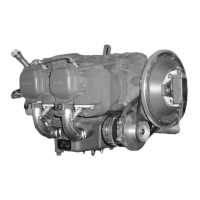LYCOMING OPERATOR’S MANUAL SECTION 5
O-320 SERIES MAINTENANCE PROCEDURES
NOTE
The hydraulic tappets, push rods, rocker arms and valves must be assembled in the same
location from which they were removed.
(7) Remove cylinder base nuts and hold down plates (where employed) then remove cylinder by
pulling directly away from crankcase. Be careful not to allow the piston to drop against the
crankcase, as the piston leaves the cylinder.
b. Removal of Valves and Valve Springs from Cylinder – Place the cylinder over a block of wood so as to
hold the valves in a closed position. Compress the valve springs using the valve spring compressor.
Remove the split keys from the end of the valve stem. The valve springs and valve spring seat may
now be removed from the cylinder head. Hold the valve stems so that the valves will not fall out and
remove the cylinder from the holding block. The valves may now be removed from the inside of the
cylinder.
c. Removal of Piston from Connecting Rod – Remove the piston pin plugs. Insert piston pin puller
through piston pin, assemble puller nut; then proceed to remove piston pin. Do not allow connecting
rod to rest on the cylinder pad of the crankcase. Support the connecting rod with heavy rubber bands,
discarded cylinder base oil ring seal, or any other non-marring method.
d. Removal of Hydraulic Tappet Sockets and Plunger Assemblies – It will be necessary to remove and
bleed the hydraulic tappet plunger assembly so that dry tappet clearance can be checked when the
cylinder assembly is reinstalled. This is accomplished in the following manner:
(1) Remove the hydraulic tappet push rod socket by inserting the forefinger into the concave end of
the socket and withdrawing. The socket will usually stick to the finger firmly enough to be pulled
out of the tappet body. If the socket cannot be removed in this manner, it may be removed by
grasping the edge of the socket with a pair of needle nose pliers. However, care must be
exercised to avoid scratching the socket.
(2) To remove the hydraulic tappet plunger assembly, use the special Lycoming service tool. In the
event the tool is not available, the hydraulic tappet plunger assembly may be removed by a hook
in the end of a short piece of lockwire, inserting the lockwire around the edge of the plunger
assembly and turning the wire so that the hook engages the spring of the plunger assembly. Draw
the plunger assembly out of the tappet body by gently pulling the wire.
CAUTION
NEVER USE A MAGNET TO REMOVE HYDRAULIC PLUNGER ASSEMBLIES FROM
THE CRANKCASE. THIS CAN CAUSE THE CHECK BALL TO REMAIN OFF ITS SEAT,
RENDERING THE UNIT INOPERATIVE.
e. Assembly of Hydraulic Tappet Plunger Assemblies – To assemble the unit, unseat the ball by inserting
a thin clean wire through the oil inlet hole. With the ball off its seat, insert the plunger and twist
clockwise so that the spring catches. All oil must be removed before the plunger is inserted.
f. Assembly of Valves in Cylinder – Prelubricate valve stems with Molytex Grease O or equivalent and
insert each valve stem in its respective valve guide. Place cylinder over a block of wood so that the
valves are held against the seats and assemble the lower valve spring seat, auxiliary valve spring and
outer valve spring over the valve stem and guide. Place the upper valve spring seat on top of the
springs.
5-7

